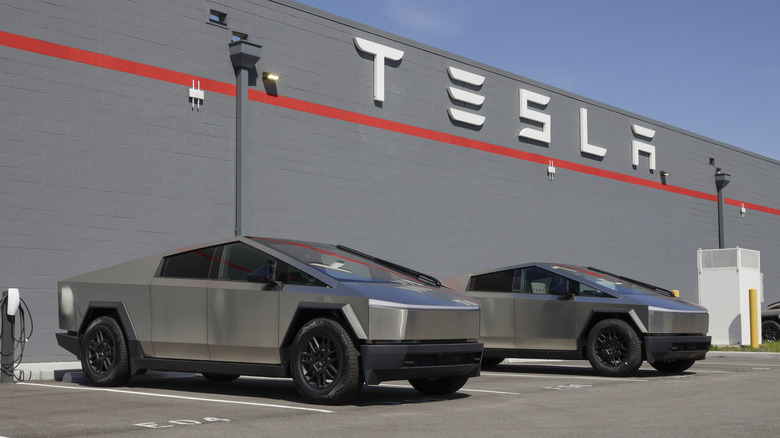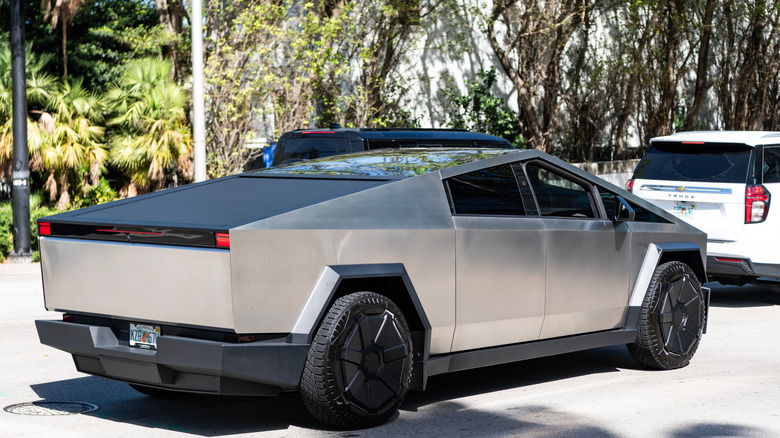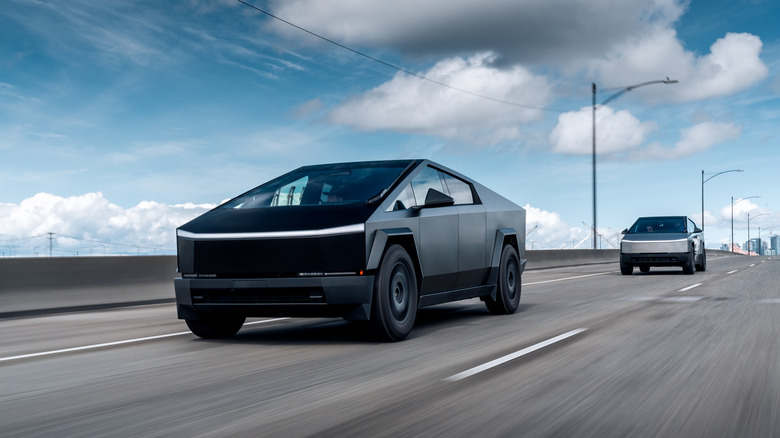Fixing A Keyed Cybertruck Is Trickier Than It Sounds - Here's Why
The Cybertruck is undoubtedly a beast of a vehicle. Its design has been controversial, but it's absolutely unmistakable. All this attention, of course, is a double-edged sword, because a parked vehicle has long been an easy target for those who object to a certain brand, model, or bumper sticker message. Acts of vandalism, like someone scratching your Cybertruck with a key, can cause more damage than you might expect.
To look at it, you might think that it's the sort of vehicle that would be difficult to damage. The Cybertruck may not really be "bulletproof" in a literal sense, but it's a hefty ride. However, it does have a weakness. Tesla's Cybertruck Owner's Manual declares the model to be less vulnerable to those pesky little dents that so infuriate proud motorists. However, it also warns that there's a downside to its steely shell: "Cybertruck does not have a clear coat on the surface of the exterior body panels, meaning any scratches that appear are in the stainless steel panels themselves."
If you've ever tentatively used a touchscreen device without a screen protector, you'll have an idea of the potential gravity of the situation. The Cybertruck's stainless steel hide certainly doesn't appreciate malicious keying, and should it be damaged in this way, those attempting to fix it could find themselves inadvertently making the problem worse. Or, rather, affecting the bodywork in a much more widespread sense.
Sanding away those imperfections
Tesla warns that anything from "bird droppings" to "industrial fallout" can damage the body of the Cybertruck and must be removed promptly. Water and detergent-free soap are recommended by the manufacturer to gently remove any residue, with all the care and diligence that a driver would be expected to show any vehicle. However, damage to the steel panels themselves should be taken care of via the rather a more heavy-handed method. As the Tesla Cybertruck Collision Repair Manual puts it, "scratches and surface discolorations of the exterior stainless steel body panels can be removed by sanding with a random orbital sander."
Those who are experienced with using this staple tool will be familiar with the differences inherent in using a random orbital sander versus an orbital sander, but if you're not, you might be more than a little nervous at the prospect of one being taken to the side of your keyed Cybertruck. After all, the Long Range version of the truck costs approximately $69,999, with the Cyberbeast weighing in at around $100,000 (pricing before any applicable savings are applied), making it no insignificant outlay for any driver. The primary issue is that application on the affected area itself will naturally leave an "uneven" look, and the Cybertruck puts aesthetics at the forefront. In order to maintain its appearance, adjacent panels should be sanded, too. The Cybertruck Collision Repair Manual explains, "the entire plane (flat area) of the panel containing the repair area must be refinished, and the same plane across all panels on the same side of the vehicle must also be refinished to maintain consistency in appearance."
The process of repairing the panels
Every driver has their own personal thoughts when it comes to the maintenance jobs they're comfortable with tackling themselves. Should a Cybertruck become scratched, though, whether accidentally or in a keying attack, Tesla suggests that refinishing is a situation that calls for the professional application of a sander. The Cybertruck Collision Repair Manual differentiates between two different types of scratch, a more minor surface scrape and a deeper gouge, and provides the correct methods for applying the sander and where to procure the tools and materials (from Grainger or Fastenal, for instance).
Some drivers will opt to protect their vehicles in different ways. Tesla offers official wraps for Cybertrucks (as well as for the Model Y and Model 3 from 2023 and later model years), priced at $4,500 in the case of the truck. Being made of polyvinyl chloride, they are far from an impenetrable layer, designed more to allow the owner to customize the looks and style of their vehicle. Stain, matte, and gloss options are available. Even so, though, it's an additional skin that the Cybertruck didn't have when fresh from the factory, and one that has the potential to alleviate the need for tricky fixes to the bodywork. This is particularly important in the case of this vehicle. Tesla's Cybertruck has some cool design features, but also something of a vulnerability as a result of its unique design approach.


